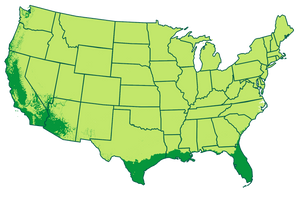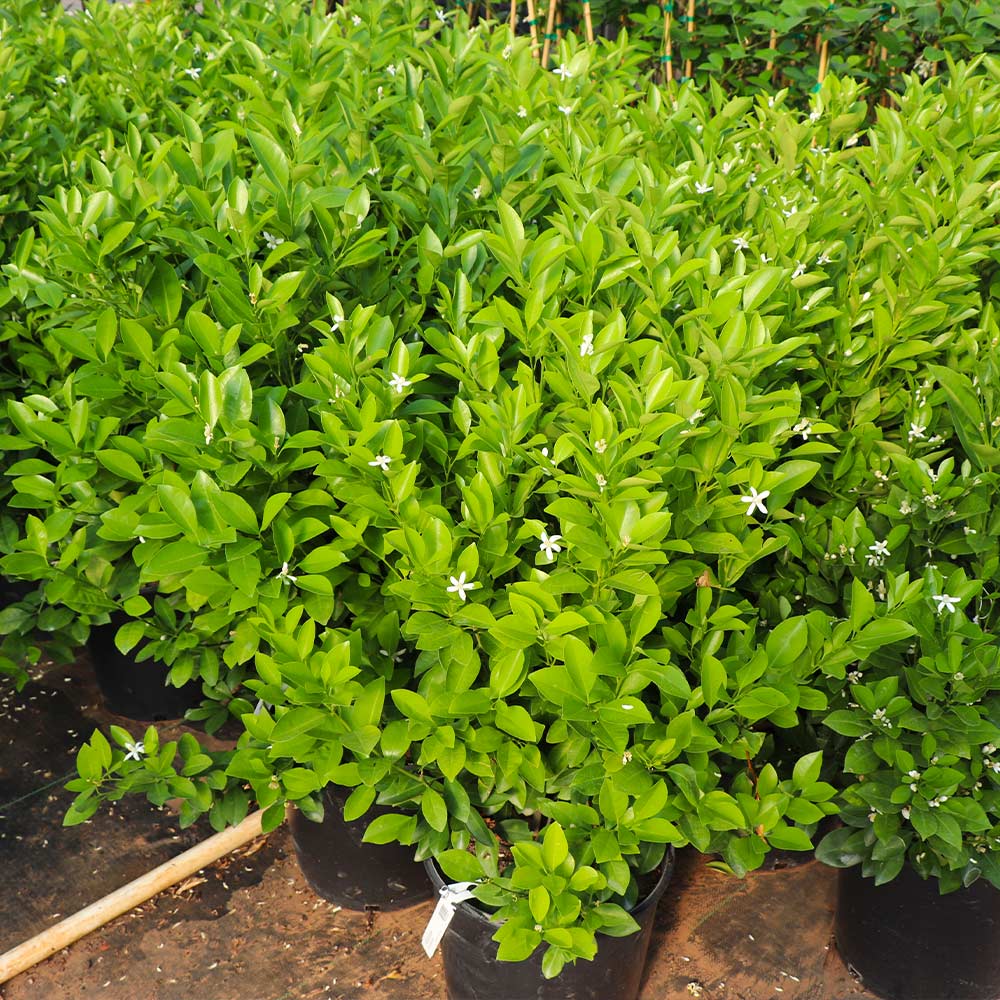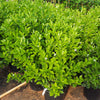* Images shown are of mature plants

Have questions? Talk with our Plant Experts (800) 973-8959
Save 25% on $200+ with code FALL25.
Questions? Call our plant experts: (800) 973-8959
Cold Hardy and Crisp Citrus
There’s nothing like the Calamondin Bush: With fruit that’s a cross between a mandarin and a kumquat, this "mini-orange,” as it’s dubbed, is wonderfully delicious.
Even better? It can be grown in a container or as a hedge. In colder climates, grow the Calamondin Bush in a container and move it indoors during winter months, or cover your outdoor bushes for chilly weather easily.
Plus, the Calamondin delights with a heavenly scent, and several flushes (harvests) of blossoms and fruit throughout the year. The yellow-orange fruit of the Calamondin Bush is about the size of a lime or a tangerine and has a thinner skin than most oranges, making it delectably delicate. It has a lightly tart taste that's perfect for marmalades, juicing, cooking and baking.
Best of all, year-round blooms give way to fruiting between June and November – and bounties after only one to two years. And younger bushes hold even more fruit.
Healthful, home-grown flavor and heightened looks – the Calamondin Bush is second to none. Order yours today!
Pollination Info
Calamondin Bush Pollination
Calamondin Bushs are self-fertile. You will get fruit with only one plant. However, adding an additional Calamondin Bush will drastically increase the size of your crop.
Planting & Care
Requiring plenty of sunshine and heat (recommended for growing outdoors in zones 8 through 11), the Calamondin Bush is one-of-a-kind. It’s also the perfect size for growing in a container if you’re in a cooler zone, but it should be brought indoors during the winter months.
The leaves on the Calamondin Bush are oval, glossy and green, accompanied by white, star-shaped flowers during the spring and a vibrant harvest between August and October.
Selecting a planting location: Choose a location where your Calamondin is going to get plenty of sunlight – around 6 to 8 hours per day is best. These plants can tolerate some shade but thrive in full sun. High humidity is also beneficial for Calamondins, so you may also need to create humidity for your bush by misting the leaves daily with water. Potted plants are ideal for placing a tray with rocks, filled with water, under the plant to feed humidity.
Planting Directions (in ground): Start by choosing a location with well-draining soil.
1) Dig a hole twice as wide and just as deep as the root system of your Calamondin Orange Bush.
2) Place it in the hole and back fill with your sandy, well-drained, acidic soil. If you have clay soil, try amending it with sand, stone, perlite or fine potting soil for best results.
3) Tamp the soil down as you fill the hole, and after planting, be sure to give your Calamondin Orange Bush a deep watering for about 5 minutes. Furthermore, mulching around the plant will help insulate the roots and keep it warm.
Planting Instructions (in container): If your winter temperatures are consistently below 40 degrees, plant your bush in a container to place outside during the summer and bring inside during the winter. Ensure that you choose a pot slightly larger than its shipped container, with plenty of holes in the bottom to allow for drainage.
1) Fill your pot halfway with soil, remove the plant from its original pot and gently place it in the potting soil.
2) Fill in around the Calamondin with the remainder of the potting soil but leave about an inch from the soil surface to the rim of the pot for easy watering.
3) Lightly pack down the soil and give your bush a deep watering until water flows from the holes in the bottom of the pot.
4) Place your bush in sun-soaked area of your home, preferably near a South-facing window. Supplement it with a grow light if it will not receive at least 6 to 8 hours of sunlight each day.
Pollination assistance: To pollinate indoors, take a small, dry, fine-tipped paintbrush and stick it into the center of a bloom. Swirl it around and collect the pollen on the brush, distributing the pollen to the next bloom and repeating the process until every bloom has been treated. Do this once daily and don’t wash the paintbrush until after the pollination process is complete. The bloom will then fall off naturally and fruit will begin to form.
Watering: Deep waterings are best for the Calamondin’s root system. After watering, allow the top 2 to 3 inches of the soil to dry out completely before the next watering.
For potted Calamondin Bushes, stick your index finger into the soil, down to about 2 inches. If there is moisture present, hold off on watering until it feels dryer at that depth. When you’re ready to water, stop once you see water escaping the drainage holes at the base of the pot.
Fertilization: Feed your Calamondin Bush during the warmer spring and summer seasons with a citrus-specific fertilizer, once every six weeks.
During the fall and winter season, fertilize your plant once every 2 to 3 months. Once the plant has matured, you can skip the cold season fertilization. The same fertilizing regimen should be followed for potted plants – simply ensure that you follow the application instructions written on the fertilizer bag.
Shipping Details
Estimated Shipping Time: Most orders ship immediately. As noted on the website, some items are seasonal, and may only ship in spring or fall. Once your order is shipped, you'll receive an email with a tracking number.
| Amount of Order | Shipping Charge |
|---|---|
| Less than $49 | $19.95 |
| $49 + | FREE SHIPPING! |
Product Details
| Mature Height: | 8 ft. |
| Mature Width: | 5 ft. |
| Sunlight: | Full-Partial |
| Growth Rate: | Moderate Growing |
| Drought Tolerance: | Good |
| Harvest Time: | August-October |
| Botanical Name: | Citrus mitis |
| Does Not Ship To: | AK, AL, AZ, CA, FL, GA, HI, LA, MS, OR, TX |
| Grows Well In Zones: | 3-11 patio / 9-11 outdoors |
| Your Growing Zone: | # |









